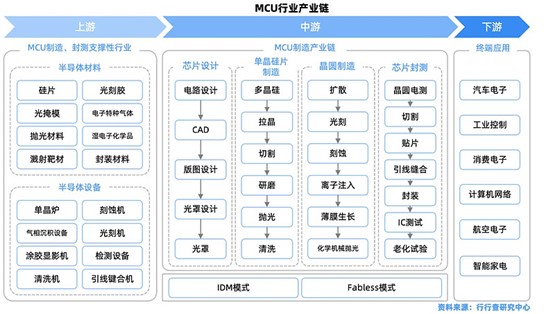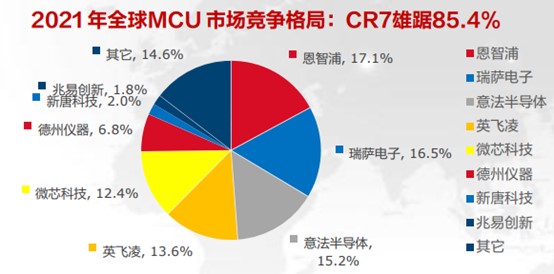Semiconductors used in automotive electronics, namely, automotive grade chips, mainly include four categories: Microprogrammed Control Unit (MCU/SoC), Insulated Gate Biopolar transistor (IGBT), Sensor Chip (CIS) and memory chip (Flash). Automatic grade chips are widely used in automotive power system, intelligent cockpit and automatic driving system, and are indispensable core components of automotive electronics.
I. Introduction of MCU chip
MCU (Micro Controller Unit), also known as Single Chip Microcomputer, is a chip-level computer with control function that integrates CPU, storage and peripheral functions on a single chip. As a highly integrated microcomputer control system, MCU has the characteristics of simple system structure, high reliability, strong processing function, low voltage and low power consumption, strong environmental adaptability, etc. It has been widely used in automotive electronics, industrial control, instruments, household appliances and other fields.
Among the various systems of automotive electronics, MCU (Automotive Microcontroller) is often used as the core of operation control, which is responsible for the calculation and processing of various information, and is used in the directions of automotive powertrain, auxiliary driving, network interconnection, chassis safety, information entertainment and body electronics.
1. The basic structure of MCU

Several important components that make up MCU include:
Central processing unit (CPU)
CPU is the brain of Single-Chip Microcomputer. It consists of an arithmetic logic unit (ALU) and a control unit (CU). The CPU reads, decodes, and executes instructions to perform arithmetic, logic, and data transfer operations.
Memory unit
Any computing system requires two types of memory: program memory and data memory. Program memory, as its name implies, contains programs, that is, instructions to be executed by CPU. On the other hand, the data store needs to store temporary data when executing instructions. Typically, program memory is Read-Only Memory (ROM) and data memory is Random Access Memory (RAM).
Input/output port
The interface between MCU and the outside world is provided by input/output port (I/O port). Input devices such as switches and keyboards provide information from the user to the CPU in the form of binary data. After receiving the data from the input device, the CPU executes appropriate instructions and responds through an output device such as an LED, a display, a printer, etc.
Timer/counter
One of the important components of Single-Chip Microcomputer is timer and counter. They provide time delays and operations to count external events. In addition, timers and counters can provide function generation, pulse width modulation, clock control, etc.
Bus
Another important component of single chip microcomputer, but rarely mentioned, is the system bus. A system bus is a set of connecting lines that connect the CPU to other peripheral devices, such as memory, I/O ports, and other supporting components.
2. The working principle of MCU
The working principle of MCU is the process of executing pre-stored instructions one by one. Different types of MCU have different instruction systems. In order for a monolithic function to perform a specific task automatically, the problem to be solved must be compiled into a series of instructions, and these instructions must be recognized and executed by a single function, so that the set of instructions becomes a program, which needs to be stored in memory with storage capacity in advance, that is, memory.
Due to the program is executed in sequence, the instructions in the program are stored one by one. When MCU executes the program, it must have the function of tracking the storage unit where the instructions are located. This part is the program counter PC (including CPU). When the program starts to run, the PC will be assigned to the storage unit of each instruction in the program and execute the instructions one by one. The contents in the PC will automatically increase, and the increase amount is determined by the length of the instruction. Each instruction points to the starting address of the next instruction to ensure the sequential execution of the instructions.
Kernel architecture is a key factor affecting the performance of MCU, and a better computing unit needs a more advanced kernel architecture. More than ten years ago, all major MCU manufacturers adopted their own kernels, such as Renesas adopting RX core, Microchip Technology adopting PowerPC, micro-core adopting PIC and Atmel adopting AVR. With the introduction of Cortex-M architecture and the unique mode of creating IP authorization, ARM has gradually occupied a dominant position because of its characteristics of software code sharing, high compatibility and highly density instruction set.
3. Types of automotive grade MCU
Automotive grade MCU can be divided into 8 bits, 16 bits and 32 bits according to bits. The number of bits is the width of data processed by MCU in a single time. The higher the number of bits, the stronger the performance of MCU. 8-bit MCU has low cost/power consumption, is easy to develop, and its performance can meet the needs of most scenes. It is widely used in basic functions such as fans, wipers, skylights, seat control and so on. 32-bit MCU has stronger computing power, can meet the needs of high-speed processing, and is mostly used to solve complex scene problems, such as intelligent cockpit, body control, assisted driving, driving safety system and other fields. ARM is the mainstream architecture of 32-bit CPU core. Due to the huge CPU instruction set, it is difficult to develop software, and the unit price is generally several times that of 8-bit MCU, so there are also high research and development barriers.

Different types of MCU
Judging from the proportion of MCU scale with different bits, the global MCU chip products are mainly 32 bits at present. Benefiting from its small size and excellent performance and the trend of intelligent automobiles, the sales proportion of 32-bit MCU has increased from 38.1% in 2010 to 53.7% in 2015, and then jumped to 65.8% in 2021. With the further development of intelligent and electrified automobiles, the electronic functions of automobiles will become increasingly complex, which inevitability promote the development of MCU with higher performance, smaller size and lower power consumption, and the proportion of 32-bit chips is expected to further increase.
Second, the general situation of MCU industry chain
The upstream of MCU industry chain is semiconductor materials and semiconductor equipment, mainly including silicon wafers, photoresists, photomasks, electronic special gases, targets, single crystal furnaces, etchers, lithography machines, etc.; The middle reaches are MCU manufacturing links, mainly including chip design, monocrystalline silicon wafer manufacturing, wafer manufacturing and chip packaging and testing; Downstream applications include automotive electronics, industrial control, consumer electronics, computer networks and so on.

Industrial chain of MCU
III. MCU market situation
1. Market size
According to the data of IC Insights, the global MCU market has increased from 15.9 billion US dollars in 2015 to 22.1 billion US dollars in 2021, and CAGR is 5.6%; In 2022, the global MCU market is expected to reach US $23.9 billion, up 8.1% year-on-year. MCU is one of the key components for the deep development of automobile from electrification to intelligence. Automobile is also the largest application market of MCU in the world, accounting for more than 1/3, and the average demand for MCU per automobile is as high as hundreds. With the technological evolution and demand upgrading of automotive semiconductor industry, intelligence will gradually become the main battlefield for competition among related manufacturers, relay electrification will become an important driving force, and MCU will benefit deeply as the core computing chip.

Source: IC Insights, Foresight Research Institute, DongHai Securities Research Institute
2. Competition pattern
According to Omdia, the MCU market is mainly controlled by chip manufacturers in Europe, America and Japan. The top seven manufacturers occupy 85.4% of the global market share, but the proportion of each enterprise is relatively average. In terms of domestic MCU market, according to the data of CSIA and China Association of Automobile Manufacturers, about 85% of domestic MCU market in 2021 (94% in 2019) is dominated by foreign capital, the localization rate of MCU is low and mostly concentrated in consumer level, and the self-sufficiency rate of vehicle-level MCU is less than 5%, so there is still much room for domestic substitution.

2021 global competitive landscape of MCU
According to Fuchang Electronics, in the fourth quarter of 2022, the global automotive semiconductor is still in short supply, and Ruyi Semiconductor, NXP and Microchip Technology, the major automotive MCU manufacturers, all have different degrees of tight supply, and both chip prices and delivery dates have increased significantly compared with the previous two quarters. The capacity expansion of overseas large factories cannot meet the market demand yet. Domestic MCU enterprises are expected to grasp this time window of mismatch between supply and demand, and cooperate with the new domestic downstream car-making forces with previous investment to accelerate the domestic substitution process of car-level MCU.
Fourth, the development trend of MCU technology
1. Higher computing power
With the continuous increase of automobile intelligence, MCU at vehicle gauge level will develop towards multi-functional integration, high computing power and ultra-low power consumption, and the number of users will also increase. At the same time, on-board sensors and on-board cameras, which are widely used in smart cars in the future, also need high-performance MCU to do analog data processing and drive control. Therefore, in the future, under the general trend of multi-sensor fusion, 32-bit or even 64-bit high-computing MCU will become the mainstream product, while 8/16-bit low-end MCU will be integrated by SOC with higher process, thus losing its growth momentum.
2. Higher integration
Due to the integration of more functions, the computing power requirements of the main control chip will increase exponentially, and some MCUs will be integrated into SoC (system on a chip) together with different types of chips such as GPU, DSP, NPU and AI processing unit. SoC is the result of higher integration of MCU, which has more complex functions and higher resource utilization efficiency, and can be competent for scenes requiring high computing power, such as unmanned driving and intelligent cockpit.
3. Higher openness
Due to the high IP licensing fee of ARM kernel, many manufacturers have started to develop MCU based on open sources RISC-V kernel, such as Renesas, Intel, Giga device Innovation and so on. RISC-V is not only completely free and open source, but also has the characteristics of low power consumption, simplified instruction set, simple design and compilation, modular support and extensibility, which is very consistent with the characteristics of fragmented scenes and modular functions of MCU at vehicle level.
General situation and development trend of Automotive grade MCU chip market-China Haihai Semiconductor (exportsemi.com)






